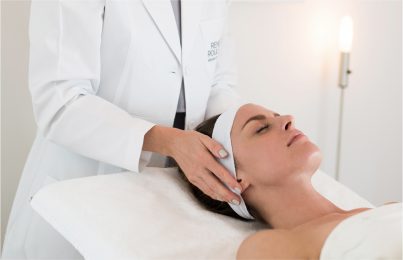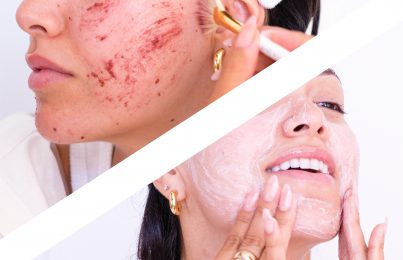Updated 05/15/22. So you just got a chemical peel. An esthetician or dermatologist applied an acid solution to your face to remove the top layers of skin along with any discolored cells. Eventually, the top layers will peel and flake away, revealing brighter, fresher, more youthful-looking skin underneath. Until then, though, you’re left with dryness, irritation, redness, and peeling, which are all perfectly common post-peel side effects. What can you do to manage these side effects and support your skin when it’s in this vulnerable state? Keep reading to learn how to care for your skin after a chemical peel!
Note: The suggestions I share in this post are for light to medium peels. These are the types of peels I perform and they’re the ones with which I have the most experience. The skincare professional who performed your peel should have given you detailed aftercare instructions. If not, you might want to consider contacting them since every peel (and skin type) is different.
How to Care for Your Skin After a Chemical Peel
Be Gentle With Your Skin
It’s so important to be very, very gentle when touching your skin after a chemical peel. Don’t use too much pressure when applying products and avoid any type of aggressive rubbing action. Some of the flaking cells will still be attached to live cells, and you don’t want to risk pulling those off when they’re not ready!
Be Extra Gentle When Your Skin Is Wet
Water melts and softens dead skin, so it’s very easy to rub off both dead and live cells when the skin is moist. Use an especially light touch when your skin is damp from cleansing or showering. And don’t use any type of washcloth or cleansing brush; it’s way too risky (but more on that in a minute).
Wear Sunscreen
This may be stating the obvious, but your skin is extremely vulnerable after a chemical peel. UV light, even if it’s a cloudy day outside, is damaging your skin. Make sure you’re protecting it with a good sunscreen formula. If your skin is super flaky, and you don’t want to touch it or rub it at all, consider using an SPF-infused powder. You can dust it on quickly and easily.
Limit Time Spent Outdoors
After a chemical peel, you want to hibernate as much as possible to keep your skin protected. Avoid exposing your skin to heat and UV light. It’s already in such an inflamed state, and you don’t want to make it worse.
Use Products With Soothing Ingredients
Provide as much comfort to your skin as possible to ease redness and irritation. I tell my clients to use a water-based gel mask (no more than once a day) if they feel like their skin is too uncomfortable. I suggest keeping it in the refrigerator to provide an extra cooling experience. I’ll either recommend the Bio Calm Repair Masque or the Rapid Response Detox Masque, depending on the client’s skin type. I will also have the client use a soothing moisturizer like the Phytolipid Comfort Creme.
Keep Your Skincare Routine Simple
If you’re wondering what to put on your face after a chemical peel, I recommend following this simple routine.
- Use a gentle, sulfate-free cleanser. The Renée Rouleau Moisture Protecting Cleanser is a great gel-to-milk formula that won’t leave the skin feeling dry.
- Mist an essence onto the skin. This is essentially the same thing as an alcohol-free toner, but it’s serum-infused for extra moisture. Normally, you’d apply it on a toning cloth and wipe it over the skin. To minimize rubbing and touching, though, you’ll want to put it in a spray bottle and mist it onto the skin. If you don’t have a spray bottle, pour it into the palm of your hand and gently pat it on the face. I recommend the Renée Rouleau Moisture Infusion Toner for this step. It deeply hydrates the skin and can be used year-round for skin types that need it.
- Apply a gentle vitamin C serum. After a chemical peel, free radical production is high. You’ll want to suppress some of that free radical activity with a gentle vitamin C serum. Plus, chemical peels can stimulate melanin activity and cause hyperpigmentation. A well-formulated vitamin C serum can help calm melanin cells. What you should know, though, is that many vitamin C serums use acid-based ingredients. You’ll want to avoid these and use serums with ingredients like Magnesium Ascorbyl Phosphate, Tetrahexyldecyl Ascorbate, Ascorbyl Methylsilanol Pectinate, or Ascorbyl Palmitate, instead. These are considered best for sensitive skin since they are stable, acid-free, and don’t cause a stinging sensation.
- Apply moisturizer. During the day, use a moisturizer with sunscreen. One with Zinc Oxide is ideal, as it will be more soothing to the skin. In the evening, use a non-sunscreen moisturizer that’s formulated for your skin type.
What Not to Do After a Chemical Peel
Don’t Pick or Pull at Your Skin
The whole purpose of a chemical peel is to lift away dry, damaged cells and reveal younger-looking cells underneath. But to do this, the skin has to shed. That’s the part that people dislike the most. It’s worth the wait, though. If you pick off dry, flaky skin that’s not ready to come off, it could cause scarring and unnecessary redness. It’s best to leave it alone!
Don’t Use a Washcloth, Facial Scrub, or Sonic Cleansing Brush
As mentioned above, dead, flaky skin softens when exposed to water. It can be very tempting to want to rub away that dryness with a washcloth, facial scrub, or sonic cleansing brush. Please don’t use any of these. Should any new cells come along with it (which they will!), you’ll wind up with scabs all over your face. I’ve seen it happen time and time again. This certainly defeats any benefits of getting the peel in the first place.
Don’t Use any Acid Ingredients
Just like how you shouldn’t use any physical exfoliants (washcloths, scrubs, or brushes), you should use any chemical exfoliants (acids and enzymes). You must let the skin shed naturally on its schedule. Acids and enzymes, whether in a cleanser, toner, serum, mask, or moisturizer, will only irritate the skin further and possibly burn and temporarily scar the skin.
Don’t Over-Moisturize
When the skin is peeling and flaky, it’s normal to want to continually apply face oil or heavy moisturizer to alleviate dryness. While it’s important to keep the skin moisturized, you don’t want to moisturize too much. After all, the whole purpose of a chemical peel is to PEEL. And the less rubbing, massaging, and tugging on the skin you do, the better.
Use a comforting moisturizer twice a day and let the skin do what it wants to do—shed. If you are going out and want to camouflage some of the flakiness, pat a few drops of face oil on the skin, like the Renée Rouealu Pro Remedy Oil.
Don’t Eat Highly Acidic Foods
When acidic foods like tomato sauce, oranges, and salsa touch the face, they can lower the pH of the skin and cause irritation. (Believe it or not, I’ve seen a lot of people get burns/rashes on the sides of their mouths after a chemical peel from eating pizza!)
When you get a chemical peel, your moisture barrier is very damaged and your skin acts extremely sensitive. Since the mouth area is the place where you’ll see the most peeling due to facial movements from talking and yawning, this area can be very reactive. It’s best to put a pause on eating acidic foods until your skin feels better.
Don’t Sweat Too Much
Especially at the height of peeling, your moisture barrier is very damaged. When you sweat while working out, the salt in your sweat can cause a stinging sensation which may further irritate your skin. I suggest doing low-impact workouts to minimize sweating during this time.
Don’t Use Retinol or Prescription Retinoids
These products stimulate cell turnover from deep within the skin. While this is normally great for the skin, it’s already happening after a chemical peel, and you don’t want to kick your skin into overdrive and cause more irritation. Just like with exfoliating acids, you’ll want to use these once your skin feels better, just not quite yet!
So there you have it. These are my best tips after over 30 years of experience giving and getting chemical peels!
Next, learn how you can give yourself a chemical peel at home.
Celebrity Esthetician & Skincare Expert
As an esthetician trained in cosmetic chemistry, Renée Rouleau has spent 30 years researching skin, educating her audience, and building an award-winning line of products. Her hands-on experience as an esthetician and trusted skin care expert has created a real-world solution — products that are formulated for nine different types of skin so your face will get exactly what it needs to look and feel its best. Trusted by celebrities, editors, bloggers, and skincare obsessives around the globe, her vast real-world knowledge and constant research are why Marie Claire calls her “the most passionate skin practitioner we know.”




Comments:
hi, i did my retinol peel 5 days ago .. Skin clinic advised me to apply sunblock atleast three times a day.. I rubbed little bit of dry skin side of my mouth two days ago ..then when i apply sunblock i felt slight burning feeling for seconds.. Now i ve got few scars in that area..pls advise what should i do .. Will theses scars go away? And i cannot still see a good results in my face.. It looks more terrible now. Thanx.
Posted By: nishu |
It sounds like your barrier is compromised due to the peel, flaking and peeling can be expected after a treatment like this. Follow a really soothing routine until your skin has calmed down and keep protecting your skin from the sun. Once your skin is healed, you can start fading these scars using Vitamin C and exfoliating acids.
Posted By: Renée Rouleau |
Hi i just got the odinary peel at home ..did not got any sort of side effect but i dont know if I shuld use dervia cms gel or not or if I shuld use vitamin c serum or not .
Posted By: Ash |
I’m not familiar with the gel, but as far as vitamin c is concerned, I would reach out to the provider of the peel to ask for post-care instructions.
Posted By: Renée Rouleau |
I have got my chemical peel done my acne got cleared. Now can I go wit normal parlour facials?? Or if I do will it cause any problems
Posted By: Sumitha |
My best advice is to find a knowledgeable esthetician you trust. There are many types of facials, and a good esthetician will be able to analyze your skin and determine what it needs. Good luck!
Posted By: Renée Rouleau |
I got a medium chemical peel (glycolic acid and TCA) done on the legs feet and arms yesterday…when can I take a bath?
Posted By: Aima |
That’s a great question! I suggest speaking with the provider of your peel for post-care specific instructions since they will know the details of your skin and your treatment.
Posted By: Renée Rouleau |
Hii, wanted to ask if we can use oils like vitamin e oil on skin as for after care chemical peeling?
Posted By: Linda |
You can use oils sparingly but it’s always best to consult with the professional who performed the peel as he or she knows your skin the best.
Posted By: Renée Rouleau |
Hello,
I had a TCA chemical peel done yesterday. Today, I have dry rough patches in some areas, and wrinkled crepey looking skin in other areas. I had beautiful, even skin tone with small pores before the peel, and now my pores look huge and I have crepey skin. I look older. My skincare professional said this was normal but I don’t feel it is. My skin isn’t flaking at all it just looks old. Is this going to fade and if so how long will it take?
Posted By: Camilla |
If you had a TCA chemical peel just done yesterday, yes, your skin is superficially dry and will look older. You have to give the skin time to shed which usually takes a few days.
Posted By: Renée Rouleau |
Hello,
I just came across your post about what to do and what not to do. Unfortunately the only directions I recieved were to moisturize so I’m on day 3 post chemical peel. Patches of my skin turned brown and peeling at the edges so I was tempted to pick and peel them off. Now I’m really worried that it’ll will cause scarring. What are the chances?
Posted By: Andrea |
It sounds like you had a very deep peel so in that case, if the instructions you were given is to moisturize, then this is certainly what you want to do. Always follow the advice of your skin care professional as they know your skin the best, as well as the type of after care needed. As for scarring, it doesn’t sound like it will, but it’s important not to pick at the dry patches. Let it run its course.
Posted By: Renée Rouleau |
Thank you for responding. The peel is almost completely gone now and my skin looks and feel great. No sign of redness or possible scarring 🙂
Posted By: Andrea |
So I’m using this glyolic face wash and it made my skin so dry, flaky, and itchy. Idk how long my face will be like this.. What should I do?
Posted By: Diane |
I would recommend you discontinue using the cleanser immediately. I would guess that your skin should return to normal within a week but it’s hard for me know for sure without all the details.
Posted By: Renée Rouleau |
I got my first peeling treatment done yesterday. As of now i have not experienced any problem. The treatment is quite expensive though. What happens if i want to stop this treatment? Will there be any side effects if i do not wish to continue with the treatment?
Posted By: Sudeshna Ghosh |
No, there should not be any side effects if you discontinue getting peels other than you’ll lose that post-peel smoothness as dead cells will start to build up again but you can help this by exfoliating well at home.
Posted By: Renée Rouleau |
Hi I’ve just had the perfect peel was expensive I’m.just in the peeling stage I want to take better care of my skin with a gentle face wash ect for sensitive skin I know I can’t use any products except water for couple weeks what product can u recommend that’s not going to cost a lot can’t see point paying all this money if I can’t mentain it in the future ,
Posted By: Paula |
A chemical peel is offering exfoliation to help with various skin issues such as brown spots, post-breakout marks and an overall smoothing of the skin. I would highly suggest that you invest in an exfoliant to use at home on a regular basis. You can see the various exfoliants that I recommend here.
Posted By: Renée Rouleau |